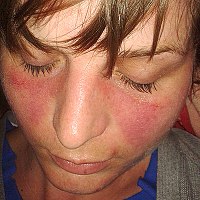
Photo from wikipedia
Cutaneous lupus erythematosus (CLE) is an autoimmune disease that can present as an isolated skin disease or as a manifestation within the spectrum of systemic lupus erythematosus. The clinical spectrum… Click to show full abstract
Cutaneous lupus erythematosus (CLE) is an autoimmune disease that can present as an isolated skin disease or as a manifestation within the spectrum of systemic lupus erythematosus. The clinical spectrum of CLE is broad, ranging from isolated discoid plaques to widespread skin lesions. Histologically, skin lesions present as interface dermatitis (inflammation of the skin mediated by anti-epidermal responses), which is orchestrated by type I and type III interferon-regulated cytokines and chemokines. Both innate and adaptive immune pathways are strongly activated in the formation of skin lesions owing to continuous re-activation of innate pathways via pattern recognition receptors (PRRs). These insights into the molecular pathogenesis of skin lesions in CLE have improved our understanding of the mechanisms underlying established therapies and have triggered the development of targeted treatment strategies that focus on immune cells (for example, B cells, T cells or plasmacytoid dendritic cells), as well as immune response pathways (for example, PRR signalling, Janus kinase (JAK)–signal transducer and activator of transcription (STAT) signalling and nuclear factor-κB signalling) and their cytokines and chemokines (for example, type I interferons, CXC-chemokine ligand 10 (CXCL10), IL-6 and IL-12). Cutaneous lupus erythematosus encompasses a broad spectrum of skin lesions that can occur in isolation or as a manifestation of systemic lupus erythematosus. Insights into the cellular and molecular pathogenesis of cutaneous lupus erythematosus have triggered the development of new therapeutic strategies. Cutaneous lupus erythematosus (CLE) occurs as isolated skin disease or in the context of systemic lupus erythematosus.Skin lesions in CLE are characterized by an interferon-orchestrated cytotoxic anti-epidermal immune response (known as interface dermatitis).Genetic variations in immune-regulation genes (such as genes involved in the type I interferon pathway, cell death, clearance of cell debris, antigen presentation, antibody production and immune cell regulation) predispose individuals to CLE.The chronic pathological cycle of CLE is fuelled by a continuous re-activation of innate immune pathways through adaptive effector mechanisms.Pharmacological inhibition of both adaptive and innate immune responses can be effective in the treatment of patients with CLE.New treatment strategies are being developed that mainly target type I interferon-producing cells (such as plasmacytoid dendritic cells) and their pathways (such as IFNAR or Janus kinase signalling). Cutaneous lupus erythematosus (CLE) occurs as isolated skin disease or in the context of systemic lupus erythematosus. Skin lesions in CLE are characterized by an interferon-orchestrated cytotoxic anti-epidermal immune response (known as interface dermatitis). Genetic variations in immune-regulation genes (such as genes involved in the type I interferon pathway, cell death, clearance of cell debris, antigen presentation, antibody production and immune cell regulation) predispose individuals to CLE. The chronic pathological cycle of CLE is fuelled by a continuous re-activation of innate immune pathways through adaptive effector mechanisms. Pharmacological inhibition of both adaptive and innate immune responses can be effective in the treatment of patients with CLE. New treatment strategies are being developed that mainly target type I interferon-producing cells (such as plasmacytoid dendritic cells) and their pathways (such as IFNAR or Janus kinase signalling).
Journal Title: Nature Reviews Rheumatology
Year Published: 2019
Link to full text (if available)
Share on Social Media: Sign Up to like & get
recommendations!